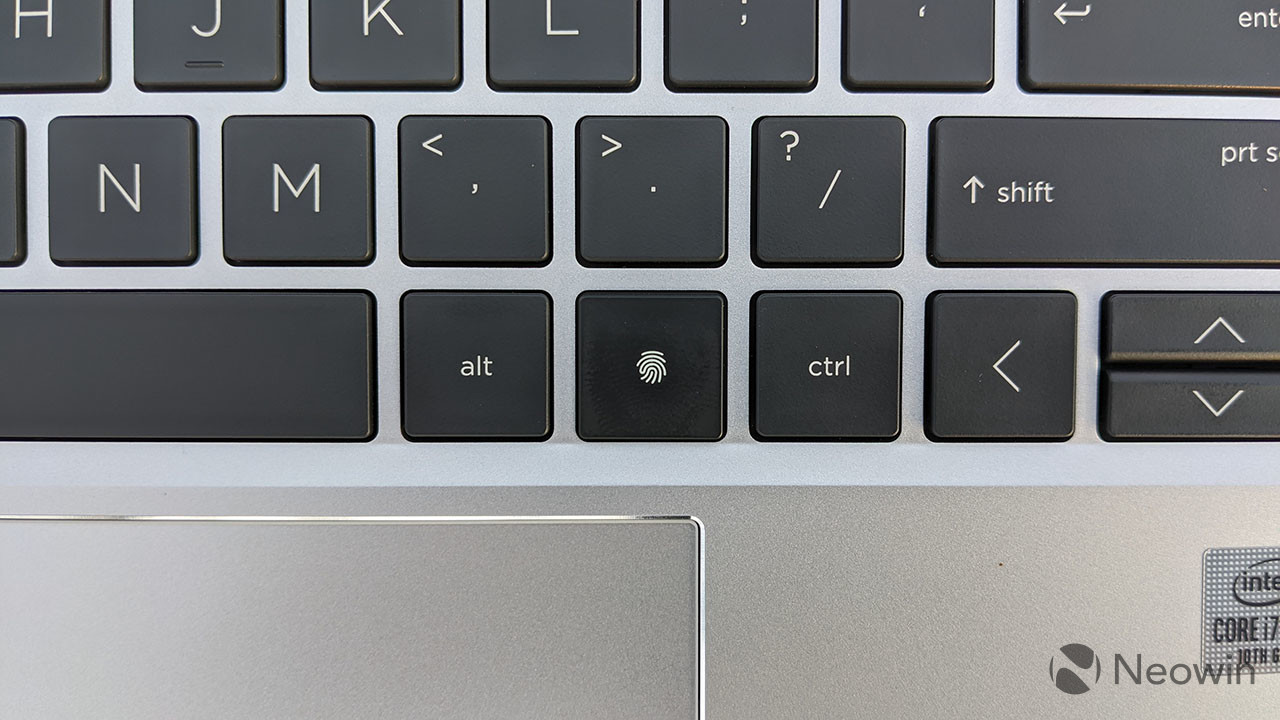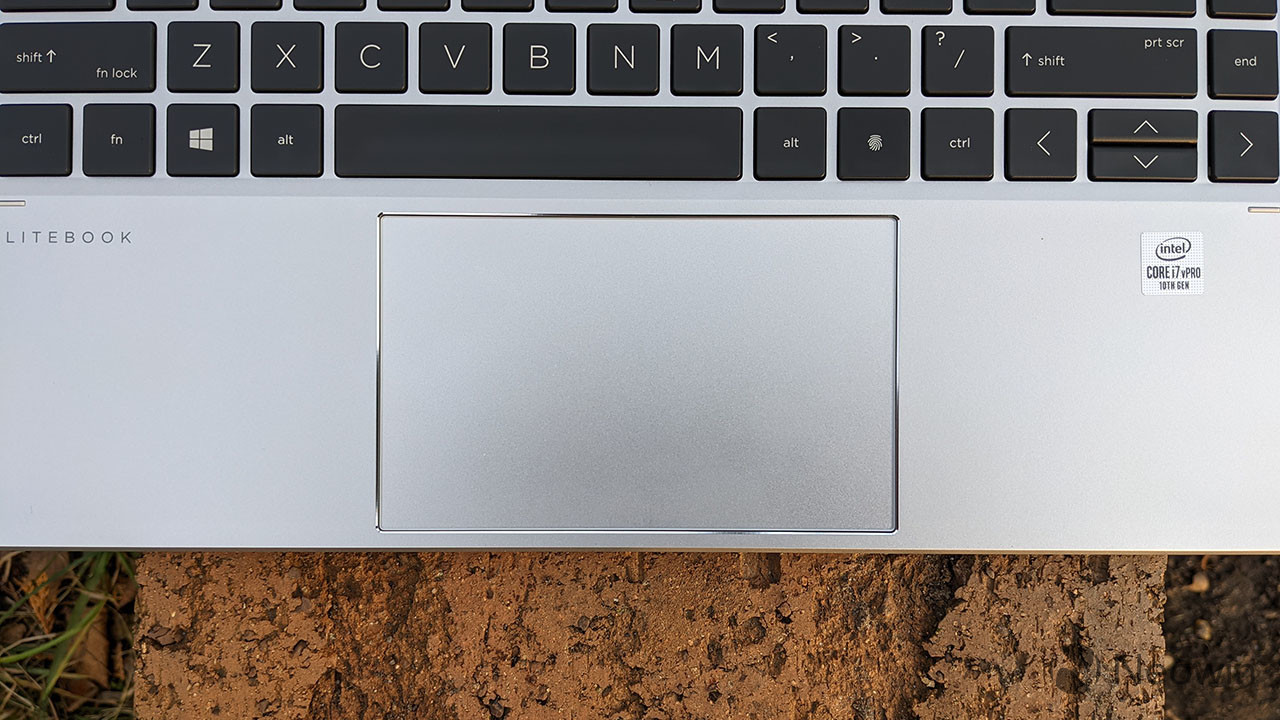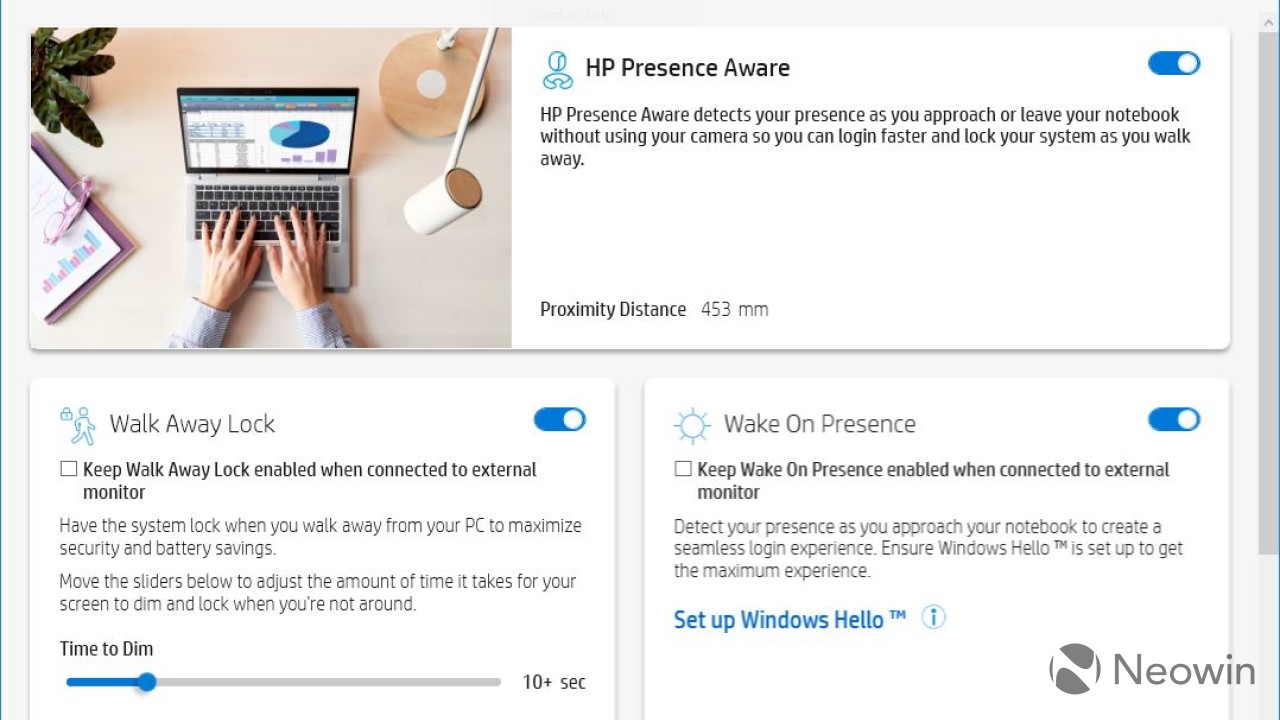Almost two years after I reviewed HP's EliteBook x360 1040 G5, it's still one of my favorite laptops. Everything about it was just perfect for the time, and now with the G7, it's even better. Along with more powerful internals like Intel's Comet Lake processors, it's been redesigned.
HP shrunk down the bezels, narrowing them down by 44% at the top, 18% on the sides, and 21% on the bottom, delivering an 89% screen-to-body ratio. Naturally, it still keeps the IR camera for Windows Hello and more.
It also keeps the premium collaboration keyboard, which I've considered to be best-in-class. In fact, it's the first keyboard that I've ever used that's challenged Lenovo's ThinkPads.
Specs
| CPU | Intel Core i7-10810U, 1.1 GHz, up to 4.9 GHz with Intel Turbo Boost technology, 12 MB cache, 6 cores, vPro |
|---|---|
| GPU | Intel UHD Graphics |
| Display | 35.56 cm (14.0 in) diagonal FHD IPS Ultraslim 2.0 mm eDP and PSR2 BrightView touchscreen with 0.4 mm Gorilla Glass 5 , 400 nits, 72% NTSC (1920 x 1080) |
| Body | 31.93x20.27x1.65cm (12.57x7.98x0.65in), 1.32kg (2.91lb) |
| Memory | 16 GB LPDDR4-2933 SDRAM |
| Storage | 512GB M.2 SSD |
| Battery | HP Long Life 4-cell, 78.6 Wh Li-ion polymer HP Smart 65 W USB Type-C adapter |
| Connectivity | Intel Dual Band Wireless-AX201 802.11a/b/g/n/ac (2x2) Wi-Fi 6 and Bluetooth 5 Combo, vPro Intel XMM 7360 LTE-Advanced Cat 9 |
| Ports |
(2) USB Type-C ports (Thunderbolt, supports Power Deliver 3.0, DisplayPort 1.2) |
| Audio |
Audio by Bang & Olufsen |
| Camera | Hybrid 720p HD/IR camera with integrated privacy shutter |
| Input |
HP Quiet Keyboard Glass clickpad with multi-touch gestures enabled (taps enabled as default) |
| Material | Aluminum |
| Color | Natural Silver |
| OS | Windows 10 Pro |
| Price | $2,499 |
The EliteBook x360 1040 G7 starts at $1,649, including a Core i5-10210U, 8GB RAM, a 256GB SSD, a smaller 54.5Wh battery, and no cellular connectivity. The specs listed above are for the model that HP sent to me to review.
Day one
Design
HP's EliteBook x360 1040 G7 still only comes in one color: Natural Silver. It's exactly what it sounds like, a traditional silver color for an aluminum laptop. I've said for years that I'd love to see HP ship its business PCs in sexier colors like we see from the Spectre lineup, but being a business PC, it's just not as practical to be flashy. However, I do still have some hope since HP made a beautiful PC in the Elite Dragonfly.
In fact, HP offered me a choice between the EliteBook x360 1030 and the 1040, and I chose the latter for a couple of reasons. One is that I feel like the 13-inch 1030 would be overshadowed by the Elite Dragonfly, and the other is that I feel like 14 inches is the perfect screen size.

This year's EliteBook x360 1040 is smaller and lighter than its predecessor. Rather than 2.98 pounds, this one comes in at 2.91 pounds, making it quite a light laptop for something that's made out of aluminum. If you want to go lighter, you'd have to go for the magnesium Elite Dragonfly. The chassis is also smaller from every dimension, so it has a more compact overall footprint.

The new EliteBook does pick up some of the design elements that we've seen across the consumer lineups, such as gem-cut edges and flat sides. In fact, the back corners are flat, almost similar to the design of the Spectre x360. It's just a nod to that design though, as the flat corners aren't wide enough to fit the power button and USB Type-C port.
Also, the front of the laptop is indented with a chamfered design. This makes it super easy to open the laptop using one hand, or just a finger.

On the right side of the device, you'll find two Thunderbolt 3 ports, HDMI 1.4b, and USB 3.2 Gen 1 Type-A. The ports are decidedly last-gen, with HP opting for the 5Gbps USB 3.2 Gen 1 instead of the 10Gbps USB 3.2 Gen 2, and opting for HDMI 1.4b when HDMI 2.0 can run a 4K display at a proper refresh rate.

On the left side, there's another USB 3.2 Gen 1 Type-A port, a 3.5mm audio jack, and a nano-SIM slot. One other thing I want to point out is that it would be really nice to have Thunderbolt 3 ports on both sides, rather than having both on the same side. It's a design that I see more frequently on Chromebooks, but it's useful. It's nice to be able to charge from either side, so cables don't get in the way of an attached mouse.
It is nice, however, that there are two USB Type-A ports and two USB Type-C ports, as many companies have moved to just one USB Type-A port.
Display and audio
As the '1040' number indicates, the EliteBook x360 1040 has a 14-inch screen, while the 1030 has a 13.3-inch display. The model that HP sent me has a 1080p resolution with 400-nit brightness. It's quite nice, definitely bright enough for any general tasks while at home or on the go.

There are other options though. One of them is Sure View, which is my personal favorite when it comes to HP displays. Sure View is a 1000-nit panel that prevents 'visual hacking', which is when someone is looking over your shoulder to see what you're looking at. It's HP's latest generation, which is called Sure View Reflect.
Interestingly, there's also an option for a 4K OLED panel, according to HP's own spec sheet. I haven't seen a 14-inch display on a PC using OLED technology in years. Hopefully, this means that we'll start seeing them again, if there's a supply for the panels.
As I mentioned above, the bezels have been shrunken down, with a 44% smaller top bezel, 18% smaller side bezels, and a 21% smaller chin. The smaller bezels and the smaller footprint that it leads to are significant, because the redesigned chassis is the main thing that differentiates it from the mainstream EliteBook 800 series, which I also recently reviewed. Honestly, if you don't want a convertible form factor and don't mind a larger footprint, then the EliteBook 840 G7 is just as good. But what we have with the EliteBook x360 1040 G7 is what you get from premium.

As far as audio quality goes, it's about what I'd expect from HP, which is to say, it's pretty good. The company is still partnering with Bang & Olufsen, which is the company that's been responsible for speakers on HP products for as long as I've been reviewing them. The speakers are placed on either side of the keyboard, and there are also speakers on the bottom of the device. That way, no matter which way you're using the convertible PC, you always have sound that's firing at you.
Keyboard and trackpad
This is my favorite part of the review because the keyboard on the EliteBook x360 1040 G7 is my favorite. Not only is it a quiet keyboard, but it's precise and comfortable. There's so little noticeable wobbliness, if there's any at all. Honestly, I think it's something that should be experienced.

The keyboard uses rubber dome switches, and while I'm always hesitant to say this, I do think that it's the best keyboard on the market. That's a title that I normally reserve for Lenovo and its ThinkPads, but after returning to an EliteBook 1000 series, I really think that HP is in the lead here. But also, it's different from a ThinkPad. This keyboard has shallower keys, while Lenovo tends to hand onto legacy tech in its ThinkPads for a while, including deeper keys and a TrackPoint.

HP is continuing its trend of putting all buttons in the keyboard, including a camera shutter button, the power button, and a fingerprint sensor. The camera shutter button places a white barrier on top of the camera, and that's meant to be visible. This is as opposed to HP's Spectres that disconnect the camera internally, and there's no visible indication of it. Also, the fingerprint is inexplicably a button. It works just fine scanning your fingerprint without pressing down on the button, so I'm not sure why it's a button that you can press, but it is what it is.

The Microsoft Precision touchpad takes advantage of the available real estate on the keyboard deck. That's not something that could be said for the previous model that I reviewed. I don't believe that it's actually a bigger touchpad though, and if it is, it's not by much. I think there's just less real estate thanks to the smaller footprint. It's a great glass touchpad though. HP really took a lot of care with the input experience here.
Software
HP's EliteBooks actually have a lot of cool features, many of which have to do with security. There's some new stuff too. One is called HP Presence Aware, and it's a feature that's been becoming more popular across business PCs.
Here's how it works. There are two options: Walk Away Lock, and Wake On Presence. For the former, you can set it so that your screen dims after up to 55 seconds, and then your PC locks after up to 55 seconds, after you walk away from your PC. Wake On Presence simply wakes up your PC when you sit in front of it, and then if you've got facial recognition set up, the IR camera will light up and you can sign in without ever touching the PC.

What's also cool is that Presence Aware isn't an app that you'll find in the Start Menu. Instead, you can access it through Settings, right where you'd find the rest of your power settings.
The other new feature is called HP QuickDrop. This lets you send files to and from your phone, and unlike Microsoft's Your Phone, it works with both Android and iOS. The bad news is that there seems to be a 50MB limit on the file size, so you can't use it for transferring video.
Performance and battery life
The model that HP sent me is pretty specced out, including an Intel Core i7-10810U processor, 16GB RAM, a 512GB SSD, and even 4G LTE. The Core i7-10810U is the vPro version of the Core i7-10710U, a 15W hexa-core CPU with 12 threads from the Comet Lake family.
To be clear, Comet Lake is the newest family of CPUs from Intel that has a vPro variant. For 10th-gen, Intel didn't do a vPro variant of Ice Lake, and while there will be a vPro version of 11th-generation 'Tiger Lake', it hasn't been announced yet. If you require those hardware-baked security features that come from vPro, and you can't wait for 10nm Tiger Lake with Iris Xe graphics, you're stuck with the 14nm Comet Lake, and the Core i7-10810U sits at the top of the lineup.

It's also completely built for productivity. You can definitely use it for some photo or video editing if you need to, but Intel's U-series hasn't taken integrated graphics very seriously until more recently. If you're looking for more powerful integrated graphics, wait for Tiger Lake, which will have Intel's newer Iris Xe graphics. HP will likely refresh the product as soon as it's available too, as it often does mid-stream spec bumps when possible.
But if you're focused on productivity with a couple dozen tabs open in a browser at any given time, this is for you, and you might get some use out of the extra cores.
Battery life is phenomenal, which isn't too surprising as this is something that HP tends to focus on. This model does have a battery that's nearly 50% larger than the one in the base model, but I was able to easily get 10 hours of actual work out of it. No, that's not 10 hours of constant playback of local videos with the brightness turned all the way down. That's actual usage. Brightness was set to 50%, and the power slider was one notch above the battery saver setting.
Obviously, your mileage may vary based on both how you use it and what configuration you get. Both the FHD Sure View display and the UHD OLED display will drain a lot more power, and if you go for the smaller battery, you'll notice significantly different results.
For benchmarks, I used PCMark 8, PCMark 10, and Geekbench 5.
| EliteBook x360 1040 G7 Core i7-10810U |
EliteBook x360 1040 G5 Core i7-8650U |
ThinkPad X1 Yoga Gen 5 Core i7-10610U |
ThinkPad T14s Ryzen 7 4750U |
|
|---|---|---|---|---|
| PCMark 8: Home | 3,721 | 3,639 | 3,033 | 4,298 |
| PCMark 8: Creative | 3,944 | 3,662 | 3,538 | 4,568 |
| PCMark 8: Work | 3,654 | 3,724 | 3,088 | 3,857 |
| PCMark 10 | 4,080 | 4,005 | 4,963 | |
| Geekbench 5 | 1,197 / 5,065 |
None of the results here are surprising at all. The Core i7-10810U is definitely the superior Intel chip for business PCs, but AMD's Ryzen PRO chips come out on top. HP does make the EliteBook 800 series with AMD's Ryzen 4000 chips, so if that's something that you're interested in, you can check it out.
Conclusion
The last time I reviewed an EliteBook x360 1040, I said that it was nearly perfect. It still is. I do have one new complaint, which is that by now, we should all be using USB 3.2 Gen 2 and HDMI 2.0. There really isn't an excuse for USB 3.2 Gen 1 anymore, especially on the premium tier. I'd also love to see some of the color options that we have on HP's consumer laptops.

But this convertible is just the best. It has the best keyboard around, and it's been a pleasure reviewing HP's laptops over the past few years while it's continued to improve on its keyboard chops. It's also got magnificent battery life, easily pulling down 10 hours of real-world usage.
That's not all though. It has a powerful hexa-core CPU, and it even has 4G LTE connectivity. If you need a business PC that you're going to take on the go, cellular connectivity isn't just more secure than using public Wi-Fi; it's more convenient too. You're just always connected as soon as you wake up your PC, wherever you are.
This configuration will run you $2,499, and if you want to find it on Hp.com, you can get it here.



























10 Comments - Add comment